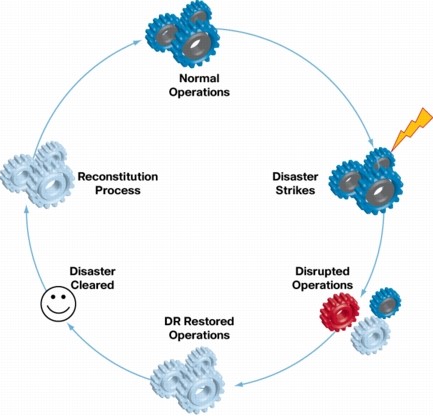“Life is not fair, get used to it.”– Bill Gates.
Bill Gates is very true in his quote that life does not guarantee happy hours on a regular basis, rather it offers an unbalanced mix of happiness and grief, disasters and achievements. Disasters are what we need to prepare for, as they come uninformed.
Mounds of moldy carpet, piles of debris, warped flooring and water-damaged furniture is the new South Louisiana, hit hard by the floods. A storm that started earlier this month wrecked more than 100,000 homes and displaced thousands of people from their homes and businesses have suffered unbelievable losses too.
Disasters are a good time to re-examine your strategies – the things that should gain precedence over others in business. So rather than scrambling to put the pieces together after a major storm, it’s better to put a Disaster Recovery (DR) plan in place on priority.
What does a disaster mean to a business?
“Not all disasters come in the form of major storms with names and categories.” – Bob Davis, CMO of Atlantis Computing.
Disasters can be in the form of electrical fires, broken water pipes, failed air conditioning units and even rogue monkeys who can cause as much damage as any storm or an earthquake.
Disasters are often unexpected and catastrophic and their impact on any business is not only financial loss or that of direct revenue, but also the loss of productivity, customer confidence and finally disruption of business continuity.
- Over 90 percent of businesses fail within two years after being struck by a disaster. – United States Small Business Administration.
- 25 percent of companies are unable to resume operations after a major disaster – Insurance Institute for Business and Home Safety.
So, you need to prepare your organization to continue, restore and resume its business operations during an outage. Plan for disaster recovery such that it hedges your business against the risk of a contingent loss.
How should a business enterprise plan its disaster recovery solution?
- Identification and classification of risks – which you think may lead to disasters.
- Determination of resources and processes – to ensure business continuity during the event of a disaster.
- A reconstitution mechanism– to get the business back to normal after the effects of the disaster are mitigated.

Business Operations Cycle of Disaster Recovery
To ensure that your business continues seamlessly in the event of any disaster, you need to consider certain factors while implementing disaster recovery plan in your organization. Here is the checklist-
1. Evaluate possible risks, threats and disaster effects
The first element to consider while planning your disaster recovery solution is identifying and evaluating the risks and threats that can bring disasters to your organization – supply chain disruptions, hardware failures, water damage and more.
Categorize them on the basis of their likelihood and impact on the business along with their restoration time. This will help you in prioritizing events that need primary attention in your disaster recovery management. Also, this will help you determine the amount to which your business can tolerate disruptions and the minimum IT service levels needed by it.
For example, in the case of a telecom service provider, risk mitigation should focus on billing operations rather than CRM operations. So cover the most critical risks, rank them in terms of your business priority and plan accordingly.
2. Calculate downtime recovery period
If you are an eBay, can you afford to be down even for a minute?
But not just eBay, every second counts for any business, so it is important to ensure that critical systems should be restored quickly, in the event of a failover.
While implementing a disaster recovery solution, determine the downtime tolerance limit for your organization as this information is essential for preparing the recovery sequence. The applications having less downtime tolerance limit should be ranked higher for recovery.
Evaluate what is the acceptable recovery point objective (RPO) and recovery time objective (RTO) for each set of applications. Public Cloud-based disaster recovery solution helps you meet your RTO requirements as it guarantees no single point of failure and faster time to recovery at a price, affordable by all business sizes.
3. Go for secure and encrypted backups
Data is the lifeblood of any business, so security of your critical data is important as without it, your company may not survive. So, you need to ensure that backup for your files, emails, databases and operating systems too, is running. You need to develop and detail special recovery procedures to restore data from backup repositories
While you make arrangements for the offsite backup locations not to be impacted by the disaster, choose backup solutions which offer online storage via a secure network connection. Cloud backup solutions are considered best alternate to tape backups as they not only deliver protection for customer’s data no matter where it resides, but also significant cost savings, shorter and improved recovery times and maximum retention years.

4. Draft effective communication plan and assign roles
A good DR plan is one in which there is an effective and quick communication strategy for the company’s employees and its authorities. It should lay out who will be responsible for what in the face of disaster.
Ensure that the records have updated employees’ contact information so that people can be called timely and they should be made to understand their roles. Choose the right cloud based online collaboration suite that allows instant team messaging, online meetings, document sharing so that team knows what is expected of them and what needs to be done in the event of an outage.
Many a times, the main communication platforms -phones and emails get effected, so alternative methods to contact people are needed. Communication plan should keep staff informed throughout the outage. Assignments like setting up workstations, redirecting phones and other tasks need proper training – arrange drills for the same.
5. Employ proper disaster recovery method
Disaster is a catch 22 situation for any company, so you need to analyze various recovery methods available and determine the best suitable recovery method for your business entities – systems, power, data network, and telephone systems
“IDC estimates that as many as 50% of organizations have inadequate disaster recovery plans and it warns that such companies might not survive after a significant disaster because of their inability to recover IT systems”
“Cloud based disaster recovery solution is considered ideal for business continuity as it delivers multiple benefits:
- Cloud services help you in virtualizing your all business essential files and databases.
- Cloud solutions eliminate the need for maintaining hardware systems by allowing you to create your own disk for storage.
- Cloud computing delivers cost- effective solution as its subscription based pricing helps you to pay for only the resources you procure.
- Other service continuity features of cloud include – online data storage, redundancy and ensured data availability on the go.
Other elements which you should include in your DR plan are-
- Schedule and test your plan regularly in accordance with regulatory/compliance requirements.
- Your service-level agreements should include steps taken during disasters/emergencies.
Services ZNetLive offer:
Managed WordPress Hosting India
If you have any doubt regarding this write-up, feel free to comment in the section below.


